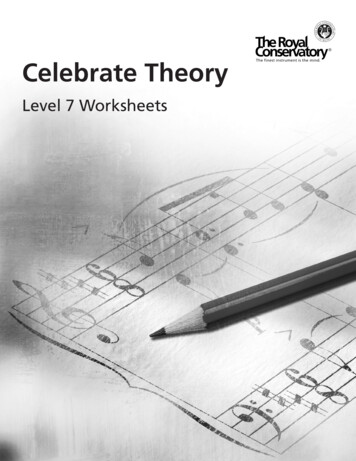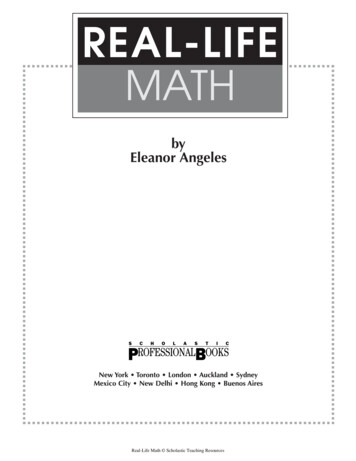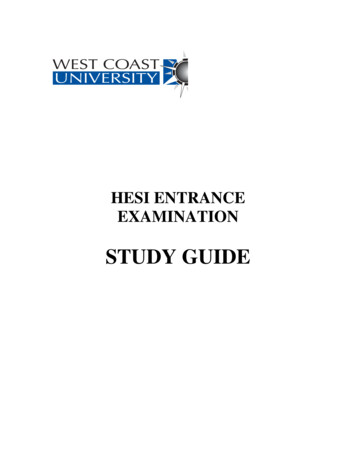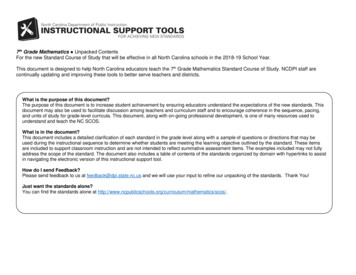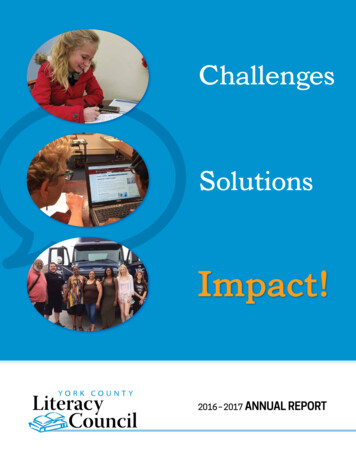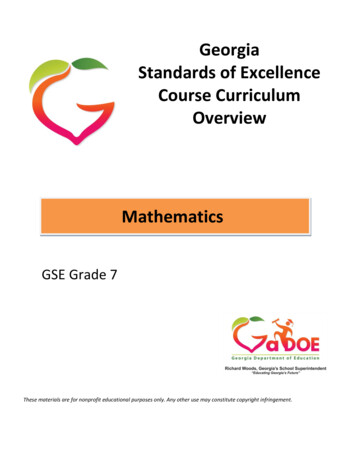
Transcription
GeorgiaStandards of ExcellenceCourse CurriculumOverviewMathematicsGSE Grade 7These materials are for nonprofit educational purposes only. Any other use may constitute copyright infringement.
Georgia Department of EducationTable of ContentsMathematics Grade 7 Curriculum Map . 3GSE Mathematics Grade 7 Critical Areas . 5GSE Mathematics Grade 7 Unit Descriptions . 5Flipbooks. 7Ratios and Proportional Relationships . 8The Number System . 9Expressions and Equations. 10Geometry. 11Statistics and Probability . 12Mathematics Standards for Mathematical Practice . . 14Connecting the Standards for Mathematical Practice to the Content Standards . 16Classroom Routines . . 16Strategies for Teaching and Learning . 16Tasks. . 18Formative Assessments Lessons (FALs) . 19Spotlight Tasks. 203-Act Tasks . 20Why Use 3-Act Tasks? A Teacher’s Response . 22Assessment Resources and Instructional Support Resources . 25Internet Resources . 277th Grade Course Curriculum OverviewJuly 2019 Page 2 of 28
Georgia Department of EducationMathematics Grade 7 Curriculum MapGSE Grade 7 Curriculum Map1st2nd SemesterSemesterClick on the link in the table to view a video that shows instructional strategies for teaching each standard.Unit 1Unit 2Unit 3Unit 5Unit 6Unit 7Unit 4(4 – 5 weeks)(4 – 5 weeks)(4 – 5 weeks)(4–5weeks)(3–4weeks)(3–4 weeks)(4 – 5 weeks)Operations withRational NumbersExpressions .4cRatios .3MGSE7.G.1GeometryInferencesProbabilityShow What .8MGSE7.SP.8aMGSE7.SP.8bMGSE7.SP.8cALLThese units were written to build upon concepts from prior units, so later units contain tasks that depend upon the concepts addressed in earlier units.All units will include the Mathematical Practices and indicate skills to maintain.NOTE: Mathematical standards are interwoven and should be addressed throughout the year in as many different units and tasks as possible in order to stress the natural connections that exist amongmathematical topics.Grades 6-8 Key:NS The Number SystemRP Ratios and Proportional RelationshipsEE Expressions and EquationsG GeometrySP Statistics and Probability.7th Grade Course Curriculum OverviewJuly 2019 Page 3 of 28
Georgia Department of EducationThis page intentionally left blank.7th Grade Course Curriculum OverviewJuly 2019 Page 4 of 28
Georgia Department of EducationThe Comprehensive Course Overviews are designed to provide access to multiple sources ofsupport for implementing and instructing courses involving the Georgia Standards ofExcellence.GSE Mathematics Grade 7 Critical AreasThe middle school standards specify the mathematics that all students should study in orderto be high school ready. The middle school standards are listed in conceptual categoriesincluding Number Sense, Algebra, Expressions and Equations, Geometry, and Statisticsand Probability.In Grade 7, instructional time should focus on four critical areas: (1) developingunderstanding of and applying proportional relationships; (2) developing understanding ofoperations with rational numbers and working with expressions and linear equations; (3)solving problems involving scale drawings and informal geometric constructions, and workingwith two and three-dimensional shapes to solve problems involving area, surface area, andvolume, and (4) drawing inferences about populations based on samples.Although the units in this instructional framework emphasize key standards and big ideas atspecific times of the year, routine topics such as estimation, mental computation, and basiccomputation facts should be addressed on an ongoing basis. Ideas related to the eightstandards for mathematical practice should be addressed constantly as well. To assure thatthese units are taught with the appropriate emphasis, depth, and rigor, it is important that thetasks listed under “Evidence of Learning” be reviewed early in the planning process. Avariety of resources should be utilized to supplement these units. These units provide muchneeded content information, but excellent learning activities as well. The tasks in theseunitsillustrate the types of learning activities that should be utilized from a variety of sources.GSE Mathematics Grade 7 Unit DescriptionsThe fundamental purpose of seventh grade mathematics is to formalize and extend themathematics that students learned in the previous grades. The critical areas, organized intounits, deepen and extend understanding of linear relationships, in part by contrasting themwith exponential phenomena, and in part by applying linear models to data that exhibit alinear trend. Seventh grade standards use algebra to deepen and extend understanding ofgeometric knowledge from prior grades. The final unit in the course ties together thealgebraic and geometric ideas studied. The Standards for Mathematical Practice applythroughout each course and, together with the content standards, prescribe that studentsexperience mathematics as a coherent, useful, and logical subject that makes use of theirability to make sense of problem situations.Unit 1 This unit builds upon the students understanding of rational numbers that was developedin 6th grade. In Grade 7, learning now moves to exploring and ultimately formalizing rules foroperations (addition, subtraction, multiplication and division) with integers. Using bothcontextual and numerical problems, students should explore what happens when negativenumbers and positive numbers are combined. Repeated opportunities over time will allowstudents to compare the results of adding, subtracting, multiplying and dividing pairs ofnumbers, leading to the generalization of the rules. Fractional rational numbers and whole7th Grade Course Curriculum OverviewJuly 2019 Page 5 of 28
Georgia Department of Educationnumbers should be used in computations and explorations. Students will be able to givecontextual examples of integer operations, write and solve equations for real-world problemsand explain how the properties of operations apply. Real-world situations could include:profit/loss, money, weight, sea level, debit/credit, football yardage, etc.Unit 2 This unit builds on what that the students learned in 6th grade regarding mathematicalproperties. They will continue to build on their knowledge of order of operations and othermathematical properties, and use these properties of operations to rewrite equivalentnumerical expressions. The students should continue to use properties that were used withwhole numbers in Grade 6 and understand that these properties apply to integers, rational andreal numbers as well. Students will also have the opportunity to write expressions andequations in more than one format and understand that they are still equal. They will begiven the opportunity to use variables to represent quantities in real-world problems.Unit 3 This unit builds on the students’ knowledge and understandings of rate and unitconcepts that were developed in Grade 6. This includes the need to develop proportionalrelationships through the analysis of graphs, tables, equations, and diagrams. Grade 7 willpush for the students’ to develop a deep understanding of the characteristics of a proportionalrelationship. Mathematics should be represented in as many ways as possible in this unit byusing graphs, tables, pictures, symbols and words. Some examples of providing the studentswith this opportunity are the following: researching newspaper ads, constructing their ownquestions, keeping a log of prices (particularly sales) and determining savings by purchasingitems on sale.Unit 4 This unit focuses on how to teach students to draw geometric figures using rulers andprotractor with an emphasis on triangles. Students will also explore two-dimensional crosssections of cylinders, cones, pyramids, and prisms. Their knowledge from 6th grade will helpwhen they are learning to write and solve equations involving angle relationships and whensolving engaging problems that require determining the area, volume, and surface area offundamental solid figures. This unit also requires students to know and use the formula forthe circumference and area of a circle.Unit 5 This unit builds on students’ knowledge and understanding of statistics from the 6thgrade. Students begin to use random samples to make predictions about an entire populationand judge the possible discrepancies of the predictions. Opportunities are provided forstudents to use real-life situations from science and social studies to show the purpose forusing random sampling to make inferences about a population.Unit 6 In this unit, students will begin to understand the probability of chance (simple andcompound). Along with the understanding of probability, they will develop probabilitymodels to be used to find the probability of events. They will make predictions and use theinformation from simulations for predictions. The students will begin to expand theirknowledge and understanding of the probability of simple events.7th Grade Course Curriculum OverviewJuly 2019 Page 6 of 28
Georgia Department of EducationFlipbooksThese “FlipBooks” were developed by the Kansas Association of Teachers of Mathematics(KATM) and are a compilation of research, “unpacked” standards from many states,instructional strategies and examples for each standard at each grade level. The intent is toshow the connections to the Standards of Mathematical Practices for the content standards andto get detailed information at each level. The Grade 7 Flipbook is an interactive documentarranged by the content domains listed on the following pages. The links on each domain andstandard will take you to specific information on that standard/domain within the Flipbook.7th Grade Course Curriculum OverviewJuly 2019 Page 7 of 28
Georgia Department of EducationRatios and Proportional RelationshipsAnalyze proportional relationships and use them to solve real‐world and mathematicalproblems.MGSE7.RP.1 Compute unit rates associated with ratios of fractions, including ratios oflengths, areas and other quantities measured in like or different units. For example, if a personwalks 1/2 mile in each 1/4 hour, compute the unit rate as the complex fraction (1/2)/(1/4) milesper hour, equivalently 2 miles per hour.MGSE7.RP.2 Recognize and represent proportional relationships between quantities.MGSE7.RP.2a Decide whether two quantities are in a proportional relationship, e.g., bytesting for equivalent ratios in a table or graphing on a coordinate plane and observingwhether the graph is a straight line through the origin.MGSE7.RP.2b Identify the constant of proportionality (unit rate) in tables, graphs,equations, diagrams, and verbal descriptions of proportional relationships.MGSE7.RP.2c Represent proportional relationships by equations. For example, if totalcost t is proportional to the number n of items purchased at a constant price p, therelationship between the total cost and the number of items can be expressed as t pn.MGSE7.RP.2d Explain what a point (x, y) on the graph of a proportional relationshipmeans in terms of the situation, with special attention to the points (0, 0) and (1,r) where ris the unit rate.MGSE7.RP.3 Use proportional relationships to solve multistep ratio and percent problems.Examples: simple interest, tax, markups and markdowns, gratuities and commissions, and fees.7th Grade Course Curriculum OverviewJuly 2019 Page 8 of 287.RP
Georgia Department of EducationThe Number System7.NSApply and extend previous understandings of operations with fractions to add, subtract,multiply, and divide rational numbers.MGSE7.NS.1 Apply and extend previous understandings of addition and subtraction to addand subtract rational numbers; represent addition and subtraction on a horizontal or verticalnumber line diagram.MGSE7.NS.1a Show that a number and its opposite have a sum of 0 (are additiveinverses). Describe situations in which opposite quantities combine to make 0. Forexample, your bank account balance is - 25.00. You deposit 25.00 into your account.The net balance is 0.00.MGSE7.NS.1b Understand p q as the number located a distance 𝑞 from p, in thepositive or negative direction depending on whether q is positive or negative. Interpretsums of rational numbers by describing real world contexts.MGSE7.NS.1c Understand subtraction of rational numbers as adding the additive inverse,p – q p (– q). Show that the distance between two rational numbers on the number lineis the absolute value of their difference, and apply this principle in real‐world contexts.MGSE7.NS.1d Apply properties of operations as strategies to add and subtract rationalnumbers.MGSE7.NS.2 Apply and extend previous understandings of multiplication and division and offractions to multiply and divide rational numbers.MGSE7.NS.2a Understand that multiplication is extended from fractions to rationalnumbers by requiring that operations continue to satisfy the properties of operations,particularly the distributive property, leading to products such as (- 1)(– 1) 1 and therules for multiplying signed numbers. Interpret products of rational numbers by describingreal‐world contexts.MGSE7.NS.2b Understand that integers can be divided, provided that the divisor is notzero, and every quotient of integers (with non‐zero divisor) is a rational number. If p and qare integers then – (p/q) (– p)/q p/(–q). Interpret quotients of rational numbers bydescribing real‐world contexts.MGSE7.NS.2c Apply properties of operations as strategies to multiply and divide rationalnumbers.MGSE7.NS.2d Convert a rational number to a decimal using long division; know that thedecimal form of a rational number terminates in 0s or eventually repeats.MGSE7.NS.3 Solve real‐world and mathematical problems involving the four operations withrational numbers.7th Grade Course Curriculum OverviewJuly 2019 Page 9 of 28
Georgia Department of EducationExpressions and Equations7.EEUse properties of operations to generate equivalent expressions.MGSE7.EE.1 Apply properties of operations as strategies to add, subtract, factor, and expandlinear expressions with rational coefficients.MGSE7.EE.2 Understand that rewriting an expression in different forms in a problem contextcan clarify the problem and how the quantities in it are related. For example a 0.05a 1.05ameans that adding a 5% tax to a total is the same as multiplying the total by 1.05.Solve real‐life and mathematical problems using numerical and algebraic expressions andequationsMGSE7.EE.3 Solve multistep real-life and mathematical problems posed with positive andnegative rational numbers in any form (whole numbers, fractions, and decimals) by applyingproperties of operations as strategies to calculate with numbers, converting between forms asappropriate, and assessing the reasonableness of answers using mental computation andestimation strategies.For example: If a woman making 25 an hour gets a 10% raise, she will make an additional 1/10 ofher salary an hour, or 2.50, for a new salary of 27.50. If you want to place a towel bar 9 3/4 inches long in the center of a door that is 27 1/2inches wide, you will need to place the bar about 9 inches from each edge; this estimatecan be used as a check on the exact computation.MGSE7.EE.4 Use variables to represent quantities in a real‐world or mathematical problem,and construct simple equations and inequalities to solve problems by reasoning about thequantities.MGSE7.EE.4a Solve word problems leading to equations of the form px q r and p(x q) r, where p, q, and r are specific rational numbers. Solve equations of these formsfluently. Compare an algebraic solution to an arithmetic solution, identifying the sequenceof the operations used in each approach. For example, the perimeter of a rectangle is 54cm. Its length is 6 cm. What is its width?MGSE7.EE.4b Solve word problems leading to inequalities of the form px q r or px q r, where p, q, and r are specific rational numbers. Graph the solution set of theinequality and interpret it in the context of the problem. For example, as a salesperson, youare paid 50 per week plus 3 per sale. This week you want your pay to be at least 100.Write an inequality for the number of sales you need to make, and describe the solutions.MGSE7.EE.4c Solve real-world and mathematical problems by writing and solvingequations of the form x p q and px q in which p and q are rational numbers.7th Grade Course Curriculum OverviewJuly 2019 Page 10 of 28
Georgia Department of EducationGeometry7.GDraw, construct, and describe geometrical figures and describe the relationships betweenthem.MGSE7.G.1 Solve problems involving scale drawings of geometric figures, includingcomputing actual lengths and areas from a scale drawing and reproducing a scale drawingat a different scale.MGSE7.G.2 Explore various geometric shapes with given conditions. Focus on creatingtriangles from three measures of angles and/or sides, noticing when the conditions determine aunique triangle, more than one triangle, or no triangle.MGSE7.G.3 Describe the two-dimensional figures (cross sections) that result from slicingthree-dimensional figures, as in plane sections of right rectangular prisms, right rectangularpyramids, cones, cylinders, and spheres.Solve real‐life and mathematical problems involving angle measure, area, surface area,and volume.MGSE7.G.4 Given the formulas for the area and circumference of a circle, use them to solveproblems; give an informal derivation of the relationship between the circumference and areaof a circle.MGSE7.G.5 Use facts about supplementary, complementary, vertical, and adjacent angles in amulti‐step problem to write and solve simple equations for an unknown angle in a figure.MGSE7.G.6 Solve real‐world and mathematical problems involving area, volume and surfacearea of two‐ and three‐dimensional objects composed of triangles, quadrilaterals, polygons,cubes, and right prisms.7th Grade Course Curriculum OverviewJuly 2019 Page 11 of 28
Georgia Department of EducationStatistics and Probability7SPUse random sampling to draw inferences about a population.MGSE7.SP.1 Understand that statistics can be used to gain information about a population byexamining a sample of the population; generalizations about a population from a sample arevalid only if the sample is representative of that population. Understand that random samplingtends to produce representative samples and support valid inferences.MGSE7.SP.2 Use data from a random sample to draw inferences about a population with anunknown characteristic of interest. Generate multiple samples (or simulated samples) of thesame size to gauge the variation in estimates or predictions. For example, estimate the meanword length in a book by randomly sampling words from the book; predict the winner of aschool election based on randomly sampled survey data. Gauge how far off the estimate orprediction might be.Draw informal comparative inferences about two populations.MGSE7.SP.3 Informally assess the degree of visual overlap of two numerical datadistributions with similar variabilities, measuring the difference between the medians byexpressing it as a multiple of the interquartile range.MGSE7.SP.4 Use measures of center and measures of variability for numerical data fromrandom samples to draw informal comparative inferences about two populations. For example,decide whether the words in a chapter of a seventh‐grade science book are generally longerthan the words in a chapter of a fourth‐grade science book.Investigate chance processes and develop, use, and evaluate probability models.MGSE7.SP.5 Understand that the probability of a chance event is a number between 0 and 1that expresses the likelihood of the event occurring. Larger numbers indicate greaterlikelihood. A probability near 0 indicates an unlikely event, a probability around 1/2 indicatesan event that is neither unlikely nor likely, and a probability near 1 indicates a likely event.MGSE7.SP.6 Approximate the probability of a chance event by collecting data on the chanceprocess that produces it and observing its long-run relative frequency. Predict the approximaterelative frequency given the probability. For example, when rolling a number cube 600 times,predict that a 3 or 6 would be rolled roughly 200 times, but probably not exactly 200 times.MGSE7.SP.7 Develop a probability model and use it to find probabilities of events. Compareexperimental and theoretical probabilities of events. If the probabilities are not close, explainpossible sources of the discrepancy.MGSE7.SP.7a Develop a uniform probability model by assigning equal probability to alloutcomes, and use the model to determine probabilities of events. For example, if a studentis selected at random from a class, find the probability that Jane will be selected and theprobability that a girl will be selected.MGSE7.SP.7b Develop a probability model (which may not be uniform) by observingfrequencies in data generated from a chance process. For example, find the approximateprobability that a spinning penny will land heads up or that a tossed paper cup will landopen‐end down. Do the outcomes for the spinning penny appear to be equally likely basedon the observed frequencies?7th Grade Course Curriculum OverviewJuly 2019 Page 12 of 28
Georgia Department of EducationMGSE7.SP.8 Find probabilities of compound events using organized lists, tables, treediagrams, and simulation.MGSE7.SP.8a Understand that, just as with simple events, the probability of a compoundevent is the fraction of outcomes in the sample space for which the compound event occurs.MGSE7.SP.8b Represent sample spaces for compound events using methods such asorganized lists, tables and tree diagrams. For an event described in everyday language (e.g.,“rolling double sixes”), identify the outcomes in the sample space which compose the event.MGSE7.SP.8c Explain ways to set up a simulation and use the simulation to generatefrequencies for compound events. For example, if 40% of donors have type A blood, createa simulation to predict the probability that it will take at least 4 donors to find one with typeA blood?7th Grade Course Curriculum OverviewJuly 2019 Page 13 of 28
Georgia Department of EducationMathematics Standards for Mathematical Practice.Mathematical Practices are listed with each grade’s mathematical content standards toreflect the need to connect the mathematical practices to mathematical content in instruction.The BLUE links will provide access to classroom videos on each standard for mathematicalpractice accessed on the Inside Math website.The Standards for Mathematical Practice describe varieties of expertise that mathematicseducators at all levels should seek to develop in their students. These practices rest onimportant “processes and proficiencies” with longstanding importance in mathematicseducation. The first of these are the NCTM process standards of problem solving, reasoningand proof, communication, representation, and connections. The second are the strands ofmathematical proficiency specified in the National Research Council’s report Adding It Up:adaptive reasoning , strategic competence, conceptual understanding (comprehension ofmathematical concepts, operations and relations), procedural fluency (skill in carrying outprocedures flexibly, accurately, efficiently and appropriately) and productive disposition(habitual inclination to see mathematics as sensible, useful, and worthwhile, coupled with abelief in diligence and one’s own efficacy).1. Make sense of problems and persevere in solving them.In grade 7, students solve problems involving ratios and rates and discuss how they solvedthem. Students solve real world problems through the application of algebraic and geometricconcepts. Students seek the meaning of a problem and look for efficient ways to represent andsolve it. They may check their thinking by asking themselves, “What is themost efficient way to solve the problem?”, “Does this make sense?”, and “Can I solve theproblem in a different way?”2. Reason abstractly and quantitatively.In grade 7, students represent a wide variety of real world contexts through the use of realnumbers and variables in mathematical expressions, equations, and inequalities. Studentscontextualize to understand the meaning of the number or variable as related to the problemand decontextualize to manipulate symbolic representations by applying properties ofoperations.3. Construct viable arguments and critique the reasoning of others.In grade 7, students construct arguments using verbal or written explanations accompanied byexpressions, equations, inequalities, models, and graphs, tables, and other data displays (i.e.box plots, dot plots, histograms, etc.). They further refine their mathematical communicationskills through mathematical discussions in which they critically evaluate their own thinkingand the thinking of other students. They pose questions like “How did you get that?”, “Why isthat true?” “Does that always work?” They explain their thinking to others and respond toothers’ thinking.4. Model with mathematics.In grade 7, students model problem situations symbolically, graphically, tabularly, andcontextually. Students form expressions, equations, or inequalities from real world contextsand connect symbolic and graphical representations. Students explore covariance andrepresent two quantities simultaneously. They use measures of center and variability and datadisplays (i.e. box plots and histograms) to draw inferences, make comparisons and formulate7th Grade Course Curriculum OverviewJuly 2019 Page 14 of 28
Georgia Department of Educationpredictions. Students use experiments or simulations to generate data sets and createprobability models. Students need many opportunities to connect and explain the connectionsbetween the different representations. They should be able to use all of these representationsas appropriate to a problem context.5. Use appropriate tools strategically.Students consider available tools (including estimation and technology) when solving amathematical problem and decide when certain tools might be helpful. For instance, studentsin grade 7 may decide to represent similar data sets using dot plots with the same scale tovisually compare the center and variability of the data. Students might use physical objectsor applets to generate probability data and use graphing calculators or spreadsheets tomanage and represent data in different forms.6. Attend to precision.In grade 7, students continue to refine their mathematical communication skills by usingclear and precise language in their discussions with others and in their own reasoning.Students define variables, specify units of measure, and label axes accurately. Students useappropriate terminology when referring to rates, ratios, probability models, geometricfigures, data displays, and components of expressions, equations or inequalities.7. Look for and make use of structure.Students routinely seek patterns or structures to model and solve problems. For instance,students recognize patterns that exist in ratio tables making connections between theconstant of proportionality in a table with the slope of a graph. Students apply properties togenerate equivalent expressions (i.e. 6 2x 3 (2 x) by distributive property) and solvee
to get detailed information at each level. The Grade 7 Flipbook is an in t erac v document arranged by the content domains The links on each domain and listed on the following pages. standard will take you to specific




